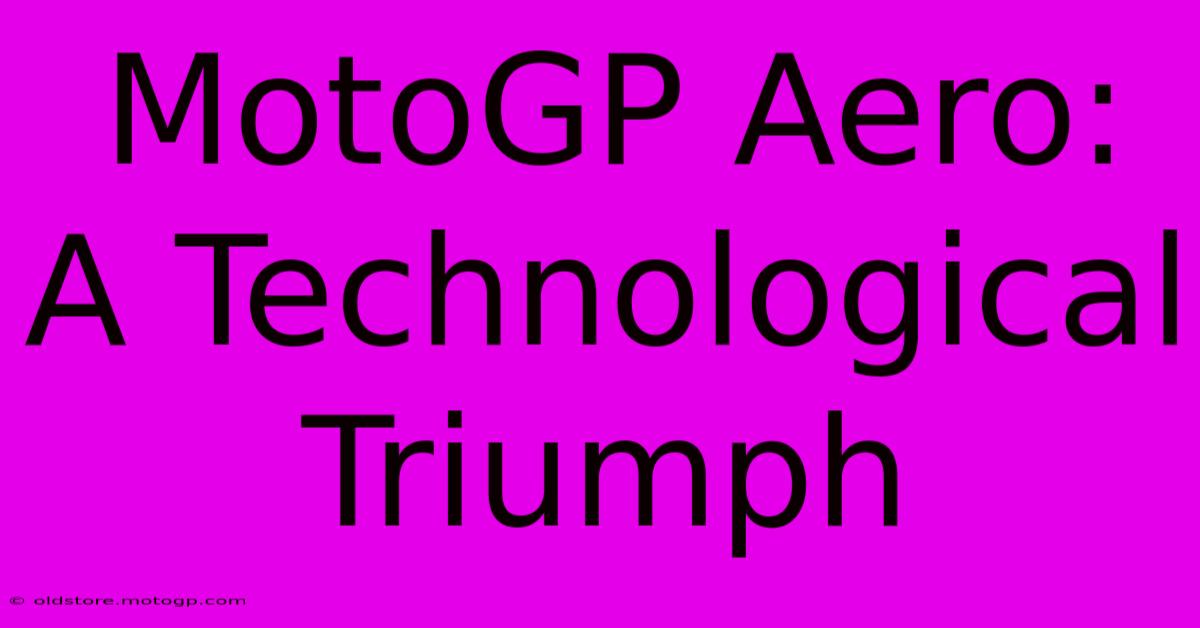MotoGP Aero: A Technological Triumph

Table of Contents
MotoGP Aero: A Technological Triumph
MotoGP, the pinnacle of motorcycle racing, is a relentless pursuit of speed and performance. Every marginal gain counts, and in recent years, aerodynamic advancements have played a pivotal role in pushing the boundaries of what's possible on two wheels. This article delves into the world of MotoGP aero, exploring its technological complexities and significant impact on the sport.
The Science of Speed: Understanding MotoGP Aerodynamics
MotoGP bikes aren't just fast; they're meticulously engineered machines where every component contributes to overall performance. Aerodynamics, the study of how air interacts with moving objects, is paramount. At high speeds, air resistance, or drag, becomes a significant force, hindering acceleration and top speed. MotoGP aero packages aim to minimize this drag while simultaneously maximizing downforce.
Downforce: The Grip Advantage
Downforce is the force pushing the bike towards the track. This increased grip is crucial for cornering speeds. Unlike cars, which use large wings, MotoGP bikes utilize a complex system of aerodynamic devices strategically placed to generate downforce without significantly increasing drag. These include:
- Winglets: Small, wing-like structures attached to the fairing, generating downforce and improving stability. Their design is incredibly complex, often employing computational fluid dynamics (CFD) simulations to optimize their effectiveness.
- Fairing Design: The fairing itself is sculpted to manage airflow around the bike, minimizing turbulence and maximizing downforce. Even small changes to the fairing's shape can significantly affect performance.
- Underbody Aerodynamics: The area beneath the bike is equally critical. Smooth underbody surfaces and carefully designed diffusers help to manage airflow and generate downforce.
The Constant Evolution of MotoGP Aero
MotoGP aero is in a state of perpetual evolution. Teams constantly experiment with new designs, striving for that elusive edge. This ongoing development is fueled by:
- Technological advancements: New materials and manufacturing techniques allow for the creation of lighter, stronger, and more aerodynamic components.
- Data analysis: Sophisticated sensors and data acquisition systems provide valuable insights into the bike's aerodynamic performance, allowing for continuous refinement of designs.
- Regulations: While pushing boundaries, MotoGP aero is subject to strict regulations designed to ensure fairness and safety. These regulations are constantly updated to balance performance with safety concerns.
The Impact on Racing
The advancements in MotoGP aero have had a profound impact on the sport:
- Increased cornering speeds: Improved downforce allows riders to carry significantly higher speeds through corners, leading to faster lap times.
- Improved stability: Better aerodynamic stability enhances rider confidence and reduces the risk of crashes, especially during high-speed maneuvers.
- Closer racing: The marginal gains achieved through aero improvements can mean the difference between victory and defeat, resulting in more intense and unpredictable races.
The Future of MotoGP Aero
The future of MotoGP aero promises even more exciting developments. We can expect to see:
- More sophisticated designs: Advanced CFD simulations and machine learning techniques will enable the creation of even more effective and efficient aerodynamic devices.
- Active aerodynamics: Systems that dynamically adjust the aerodynamic configuration of the bike based on track conditions and speed could become a reality.
- Sustainable solutions: The industry is exploring eco-friendly materials and manufacturing processes to reduce the environmental impact of MotoGP aero.
Conclusion:
MotoGP aero is a testament to human ingenuity and the relentless pursuit of performance. It's a fascinating blend of science, engineering, and artistry, driving the sport forward and creating some of the most thrilling races in the world. The constant evolution of this technology guarantees that the future of MotoGP will remain exciting and unpredictable. The quest for aerodynamic perfection continues, pushing the limits of what's possible on two wheels and captivating fans worldwide.

Thank you for visiting our website wich cover about MotoGP Aero: A Technological Triumph. We hope the information provided has been useful to you. Feel free to contact us if you have any questions or need further assistance. See you next time and dont miss to bookmark.
Featured Posts
-
Gp Results Understand Your Numbers Improve Your Health
Feb 23, 2025
-
Qualifying Results Moto Gp Riders Fight For Every Inch On The Grid
Feb 23, 2025
-
Tnt Sports Moto Gp Your Ticket To The Grand Prix
Feb 23, 2025
-
Did They Crash Or Conquer Moto Gp Sprint Race Results
Feb 23, 2025
-
Moto Gp Crash Today Race Resumes After Delay
Feb 23, 2025
